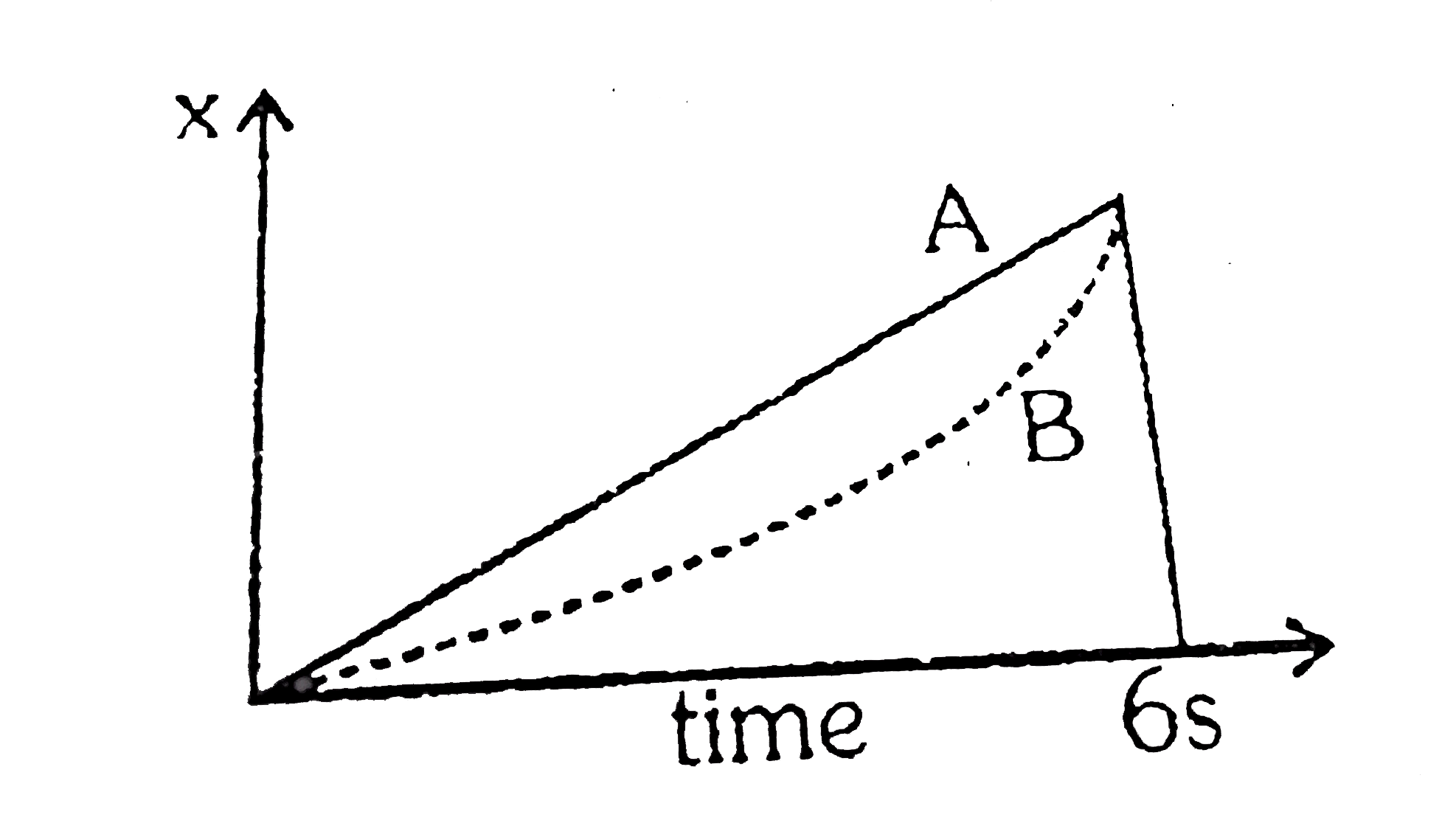When two particles A and B are at point O, A is moving with a constant velocity 50 m/s , while B is not moving. But B possesses a constant acceleration of 10 m/s2 . After how much time they will be at a distance of 125 m ?
To solve the problem step by step, we will analyze the motion of both particles A and B and find the time when they are at a distance of 125 meters apart.
Step 1: Identify initial conditions
- Particle A is moving with a constant velocity UA=50m/s.
- Particle B is initially at rest, so UB=0m/s.
- Particle B has a constant acceleration aB=10m/s2.
- The acceleration of A is aA=0m/s2 since it moves with constant velocity.
Step 2: Establish the relative motion
To analyze the motion of A with respect to B, we need to calculate the relative velocity and acceleration:
- The relative velocity UAB=UA−UB=50m/s−0m/s=50m/s.
- The relative acceleration aAB=aA−aB=0m/s2−10m/s2=−10m/s2.
Step 3: Use the equation of motion
We need to find the time T when the distance SAB between A and B is 125 m. The equation of motion we will use is:
SAB=UAB⋅T+12aAB⋅T2
Substituting the known values:
125=50T+12(−10)T2
This simplifies to:
125=50T−5T2
Step 4: Rearranging the equation
Rearranging the equation gives:
5T2−50T+125=0
Dividing the entire equation by 5:
T2−10T+25=0
Step 5: Factoring the quadratic equation
This quadratic can be factored as:
(T−5)(T−5)=0
Thus, we have:
(T−5)2=0
Step 6: Solve for T
Taking the square root gives:
T−5=0⟹T=5seconds
Final Answer
The time after which particles A and B will be at a distance of 125 m apart is T=5seconds.
---
- Particle A is moving with a constant velocity UA=50m/s.
- Particle B is initially at rest, so UB=0m/s.
- Particle B has a constant acceleration aB=10m/s2.
- The acceleration of A is aA=0m/s2 since it moves with constant velocity.
To analyze the motion of A with respect to B, we need to calculate the relative velocity and acceleration:
- The relative velocity UAB=UA−UB=50m/s−0m/s=50m/s.
- The relative acceleration aAB=aA−aB=0m/s2−10m/s2=−10m/s2.
We need to find the time T when the distance SAB between A and B is 125 m. The equation of motion we will use is:
SAB=UAB⋅T+12aAB⋅T2
Substituting the known values:
125=50T+12(−10)T2
This simplifies to:
125=50T−5T2
Rearranging the equation gives:
5T2−50T+125=0
Dividing the entire equation by 5:
T2−10T+25=0
This quadratic can be factored as:
(T−5)(T−5)=0
Thus, we have:
(T−5)2=0
Taking the square root gives:
T−5=0⟹T=5seconds
The time after which particles A and B will be at a distance of 125 m apart is T=5seconds.
Topper's Solved these Questions
- MOTION IN A PLANEBook:AAKASH INSTITUTE ENGLISHChapter:MOTION IN A PLANEExercise:llustration 1 :
Explore 1 Video
- MOTION IN A PLANEBook:AAKASH INSTITUTE ENGLISHChapter:MOTION IN A PLANEExercise:Try yourself
Explore 48 Videos
- MOCK_TEST_17Book:AAKASH INSTITUTE ENGLISHChapter:MOCK_TEST_17Exercise:Example
Explore 15 Videos
- MOTION IN A STRAIGHT LINEBook:AAKASH INSTITUTE ENGLISHChapter:MOTION IN A STRAIGHT LINEExercise:ASSIGNMENT (SECTION - D)
Explore 15 Videos
Similar Questions
Two cars A and B are at rest at same point initially. If A starts with uniform velocity of 40 m/sec and B starts in the same direction with constant acceleration of4m/s2,then B will catch A after :
View SolutionTwo particles A and B are initially 40mapart, A is behind B. Particle A is moving with uniform velocity of 10ms−1 towared B. Particle B starts moving away from A with constant acceleration of 2ms−1.
The time which there is a minimum distance between the two is .
View SolutionA particle of mass 2kg starts moving in a straight line with an initial velocity of 2m/s at a constant acceleration of 2m/s2. Then rate of change of kinetic energy.
View SolutionA cyclist starts from rest and moves with a constant acceleration of 1 m/s2. A boy who is 48 m behind the cyclist starts moving with a constant velocity of 10m/s. After how much time the boy meets the cyclist?
View SolutionTwo cars A and B are moving on parallel roads in the same direction. Car A moves with constant velocity 30m/s and car B moves with constant acceleration 2.5m/s2 . At , car A is ahead of car B and car B is moving with 12m/s velocity . The distance travelled by car B until it overtakes car A is
View SolutionA particle starts moving with constant, velocity v=2ms, from position x=5m The position time graph will be
View SolutionA particle starts from the origin at t = 0 s with a velocity of 10.0ˆj m/s and moves in plane with a constant acceleration of (8ˆi+2ˆj)ms−2. The y-coordinate of the particle in 2 sec is
View SolutionA particle starts from the origin at t=Os with a velocity of 10.0ˆjm/s and moves in the xy-plane with a constant acceleration of (8ˆi+2ˆj)m/s−2. What time is the x-coordinate of the particle 16m?
View SolutionIn the diagram shown, the displacement of particles is given as a function of time. The particle a is moving under constant velocity of 9m/s. The particle B is moving under variable acceleration. From time t=0s to t=6s. The average velocity of the particle B will be equal to :-

View SolutionOut of the two cars A and B car A is moving towards east with velocity of 10 m/s whereas B is moving towards north with a velocity 20 m/s, then velocity of A w.r.t B is ( nearly )
View Solution